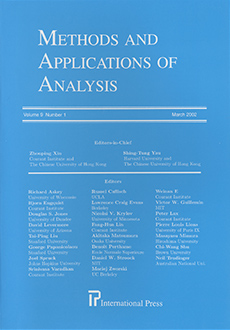Abstract
Wavelet methods with polynomial filters are usually favored in applications for their fast wavelet transforms and compact support. However, wavelet methods with rational filters have more freedom to achieve smaller condition numbers, more regularity and better efficiency. Such methods can be attractive if they also possess fast algorithms and have fast decay (as if the corresponding wavelets had compact support). In the first part of this paper, we propose a new wavelet method with rational filters which do have these properties. We call it the difference wavelet method. It is a generalization of Butterworth wavelets. The analysis part is simply averaging and finite differencing. The wavelet coefficients measure the finite differences of the averages of an input data sequence. Its synthesis part involves rational filters, which can be performed with linear computational complexity by the cyclic reduction method. Their Riesz basis property, biorthogonality, decay and regularity are investigated.
In the second part of this paper, we perform comparison studies of the difference wavelet method (Diff) with three other popular wavelet methods: the Cohen-Daubechies-Feauveau biorthogonal wavelets (CDF), the Daubechies orthogonal wavelets (Daub) and the Chui-Wang semi-orthogonal wavelets (CW). Natural criteria in designing good wavelet methods for representing functions and operators are speed, stability and efficiency. Therefore, the items of our first comparison include (i) operation counts for performing transformations, (ii) condition numbers of the wavelet transformations, (iii) compression ratios, by some numerical experiments, for representing (smooth or non-smooth) data sequences and matrices (smooth or non-smooth kernels). The results show that (i) Diff, Daub and CDF have about the same operation counts, and CW has more; (ii) Diff has about the same condition numbers as those of CDF and CW; (iii) Diff has better compression ratio for both (smooth or non-smooth) data sequences and matrices (smooth or non-smooth kernels).
The items of our second comparison include regularity, approximation power (the constant in the approximation estimate), approximation errors for non-smooth functions (where Gibbs phenomena appear) and the “essential supports.” The results show that Diff has better regularity and better approximation ability with only slightly bigger essential supports. It is evident that the better efficiency of Diff for smooth functions is due to its regularity. It is surprising that, even for nonsmooth functions, Diff is comparable to, sometimes even superior to, other methods, despite its infinite-support property.
This paper is organized as follows. Sec. 1 is preliminary. Sec. 2 provides the theory of the difference wavelet method. Sec. 3 contains the comparison studies. Experts are suggested to read Sec. 3 directly.
Citation
I-Liang Chern. Chien-Chang Yen. "Difference Wavelet - Theory and A Comparison Study." Methods Appl. Anal. 9 (4) 469 - 492, December 2002.
Information





